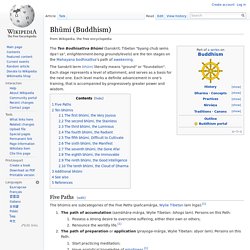

Pāramitā. Pāramitā (Pāli; Sanskrit; Devanagari: पारमिता) or pāramī (Pāli) is "perfection" or "completeness.

"[1] In Buddhism, the pāramitās refer to the perfection or culmination of certain virtues. In Buddhism, these virtues are cultivated as a way of purification, purifying karma and helping the aspirant to live an unobstructed life, while reaching the goal of enlightenment. Etymology[edit] Scholar Donald Lopez describes the etymology of the term: The term pāramitā, commonly translated as "perfection," has two etymologies. Theravāda Buddhism[edit] Theravāda Buddhism's teachings on the pāramitās can be found in late canonical books and post-canonical commentaries. Canonical sources[edit] In the Pāli canon's Buddhavaṃsa[3] the Ten Perfections (dasa pāramiyo) are (original terms in Pāli): Two of the above virtues, metta and upekkha also comprise two of the four immeasurables (brahmavihāra).
Historicity[edit] Traditional practice[edit] Mahāyāna Buddhism[edit] 7. 8. 10. Tibetan Buddhism[edit] Bhūmi (Buddhism) The Ten Bodhisattva Bhūmi (Sanskrit; Tibetan "byang chub sems dpa'i sa", enlightenment-being grounds/levels) are the ten stages on the Mahayana bodhisattva's path of awakening.

The Sanskrit term bhūmi literally means "ground" or "foundation". Each stage represents a level of attainment, and serves as a basis for the next one. Each level marks a definite advancement in one's training, that is accompanied by progressively greater power and wisdom. The bhūmis are subcategories of the Five Paths (pañcamārga, Wylie Tibetan lam lnga):[1] The path of accumulation (saṃbhāra-mārga, Wylie Tibetan: tshogs lam). Passage through the grounds and paths begins with Bodhicitta, the wish to liberate all sentient beings.
Before attaining the ten grounds, the bodhisattva traverses the first two of the five Mahayana paths: The path of accumulationThe path of preparation The ten grounds of the bodhisattva are grouped within the three subsequent paths: The Avataṃsakasūtra refers to the following ten bhūmis:[4] Bodhisattva. Bodhicitta. Etymology[edit] Etymologically, the word is a combination of the Sanskrit words bodhi and citta.

Bodhi means "awakening" or "enlightenment". Citta derives from the Sanskrit root cit, and means "that which is conscious" (i.e., mind or consciousness). Bodhicitta may be translated as "awakening mind" or "mind of enlightenment". Spontaneity[edit] Bodhicitta is a spontaneous wish to attain enlightenment motivated by great compassion for all sentient beings, accompanied by a falling away of the attachment to the illusion of an inherently existing self. The mind of great compassion and bodhicitta motivates one to attain enlightenment Buddhahood, as quickly as possible and benefit infinite sentient beings through their emanations and other skillful means. A person who has a spontaneous realization or motivation of bodhicitta is called a bodhisattva.
Levels[edit] Different schools may demonstrate alternative understandings of bodhicitta. The Eight Auspicious Signs by Kyabje Lama Zopa Rinpoche. By Kyabje Lama Zopa Rinpoche at Bodhgaya, India (Last Updated Nov 18, 2014) Probably many of us do not know how important these eight auspicious signs are and how they affect our lives.

They can be used externally to help for one’s own success as well as for the FPMT organization to be successful in benefiting others and working for the teachings of the Buddha. Putting these eight auspicious signs around everywhere, outside and also inside the rooms makes things very auspicious. It is not necessary to put all eight together and they don’t all need to be in the same place, they can be placed separately at different locations but you should have all of them. The eight auspicious signs are the Umbrella Yellow fish Vase Lotus White conch shell Glorious peu1 Banner Dharma chakra Here is the meaning of these eight auspicious signs according to my Root Guru His Holiness Trijang Dorje Chang’s explanation.2 1. 2. 3. 4. 5. 6. 7. 8.
Dharma (Buddhism)